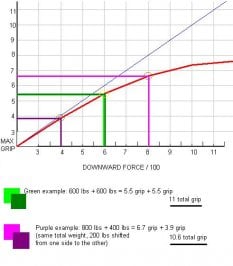Wait, there is yet hope, and no offense DrBiggly, thanks for your excellent comparitive analysis- do I HAVE to doubt you to see your racecar, btw? This is an important consideration when comparing data or measuring systems. All values must be of the same unit measurement to derive any useful meaning from comparing data. It is concievable that real world tuners can use thier hard learned numbers for ride height and spring rates, two very important factor in suspension dynamics. But is anyone outside of the Polyphony crowd able to define a shock compression value of 5? And is that 5 half of 10 or, like on the Richter scale, could it be half of 6? And are these values absolute- 1 has a specific number in any application, on any car, or are they relative- 1 is the lowest of 10 values you could use specific to this particular application (car). Then there are the sway bars; a value of 3 would be, um 3 inches? Perhaps 3 mm? Or it is measured in strength, so 3 would be 3 times stronger than 1...or maybe it is 3 arm wrestles stronger than 1...3 horsepower?
You can, of course, see how these "nuances" might affect MrBigglys game WRX. For every unnasigned value he must take his real world number and convert it into every possible unit of measurement and try each one and each combination of "re"assigned numbers while he is at it. In other words, if a number applies to a torque value, he must convert it to lbs/inch, lbs/ft, newtons, joules/kg, etc. Until he has done this he can learn nothing aside from the fact that the programmers use a different (and perhaps alien) measuring scale.
Personally, I prefer the empircal school of tuning, real world theory is an good basis to understand what the programmers were trying to accomplish, but there is no way they could have factored every variable into their equations. In the final distillation, when you use real world values, you are comparing mathematics to mechanics and you mustn't get lost in translation.
 Now that I think of it, I basically learned this formula because of this thread so "Thanks" tuning is fun again.
Now that I think of it, I basically learned this formula because of this thread so "Thanks" tuning is fun again. 


 .
. .
. .
.
 ) the tire model is. Individual tire pressures and tire temperatures (inner, middle, outer) would help us set up the cars since we don't know what units (or even the ratio's/relative'ness) of all the adjustments. As aarque said, just by testing and making small adjustments is going to get you the farthest.
) the tire model is. Individual tire pressures and tire temperatures (inner, middle, outer) would help us set up the cars since we don't know what units (or even the ratio's/relative'ness) of all the adjustments. As aarque said, just by testing and making small adjustments is going to get you the farthest.


 .
.
